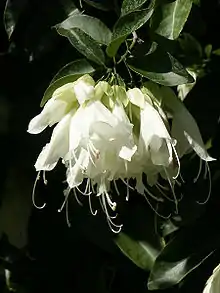Oxera
Oxera is a genus of flowering plants in the family Lamiaceae native to Vanuatu and New Caledonia in the western Pacific.[1]
| Oxera | |
|---|---|
 | |
| Oxera pulchella | |
| Scientific classification | |
| Kingdom: | Plantae |
| Clade: | Tracheophytes |
| Clade: | Angiosperms |
| Clade: | Eudicots |
| Clade: | Asterids |
| Order: | Lamiales |
| Family: | Lamiaceae |
| Subfamily: | Ajugoideae |
| Genus: | Oxera Labill. |
| Type species | |
| Oxera pulchella Labill. | |
| Synonyms[1] | |
| |
Description
Species of Oxera show a variety of growth forms, including lianas, shrubs and trees.[2][3] The leaves are simple, and are petiolate (on short stalks), except in O. sessilifolia,[2][3] with entire or occasionally sinuate (wavy) edges.[3]
The inflorescences are loose thyrses of flowers, growing from leaf axils (axillary) or directly from the stem (cauliflory).[2][3] The flowers are large, conspicuous and bisexual; the calyx is actinomorphic (rotationally symmetrical), but the corolla is zygomorphic, sometimes strongly so.[2][3] Although some species have four stamens in each flower, they are usually reduced in number with two stamens, usually the posterior pair, forming staminodes instead.[2][3]
Distribution
Twenty of the twenty-one species are found on the island of Grande Terre (the main island of New Caledonia). Three species occur on the adjacent island of Île des Pins, two on Lifou and one on Maré in the Loyalty Islands, and two on Vanuatu (including one introduced species).[2]
Oxera vanuatuensis is only known from Vanuatu, where it is only known from cultivated specimens.[2] Villagers on Pentecost Island (and their descendants on Maewo call the tree harongmau, and propagate the species by planting seeds, transplanting seedlings or taking cuttings.[2] The plant is thought to treat illnesses caused by black magic, and profuse flowering from the trunk is thought to foretell a good harvest of yams.[2]
Species
Twenty-one species are recognised in the genus Oxera, in five informal species groups:[2][Note 1]
- baladica group
- Oxera baladica Vieill.
- Oxera sessilifolia Dubard
- Oxera subverticillata Vieill.
- Oxera vanuatuensis de Kok – Vanuatu
- robusta group
- Oxera coriacea Dubard
- Oxera coronata de Kok
- Oxera palmatinervia Dubard
- Oxera robusta Vieill.
- pulchella group
- Oxera balansae Dubard – Grande Terre, Île des Pins, Lifou
 [4]
[4] - Oxera brevicalyx (Moldenke) de Kok
- Oxera crassifolia Virot
 [5]
[5] - Oxera morierei Vieill.
- Oxera pulchella Labill.
 [6]
[6]
- sulfurea group
- Oxera gmelinoides S. Moore
- Oxera microcalyx Guillaumin
- Oxera rugosa Guillaumin
- Oxera sulfurea Dubard – Grand Terre, Île des Pins, Lifou, Maré
- macrocalyx group
- Oxera glandulosa Vieill. – New Caledonia, Île des Pins
- Oxera neriifolia (Montrouz.) Beauvis. [Note 2]
- Oxera macrocalyx Dubard
 [8]
[8] - Oxera oreophila Guillaumin
Taxonomic history
The genus Oxera was erected by Jacques Labillardière in 1824, based on a single specimen that he had collected in New Caledonia.[2] The closest relative of Oxera is the genus Faradaya, and the two genera were once united as the tribe Oxereae.[2] Collectively, they are the sister group to a clade containing Clerodendrum and a number of segregate genera such as Kalaharia, Huxleya, Amasonia and Tetraclea.[9][10] Both genera are now treated as members of the subfamily Teucrioideae, following work published by Philip D. Cantino in 1992.[2]
Notes
- All species are endemic to Grande Terre unless otherwise noted. Conservation statuses follow the IUCN Red List: EN = endangered species; VU = vulnerable species; LC = Least Concern.
- Although "O. neriifolia" was treated as a nomen dubium by de Kok (1999),[2] it has since been accepted as the valid name for the species named "Oxera inodora" by de Kok.[7]
References
- Kew World Checklist of Selected Plant Families
- R. P. J. de Kok & D. J. Mabberley (1999). "A synopsis of Oxera Labill. (Labiatae)". Kew Bulletin. 54 (2): 265–300. doi:10.2307/4115808. JSTOR 4115808.
- R. M. Harley; S. Atkins; A. L. Budantsev; P. D. Cantino; B. J. Conn; R. Grayer; M. M. Harley; R. de Kok; T. Krestovskaja; R. Morales; A. J. Paton; O. Ryding; T. Upson (2004). "Labiatae". In J. W. Kadereit (ed.). Flowering plants, Dicotyledons. Lamiales (except Acanthaceae including Avicenniaceae). The Families and Genera of Vascular Plants. 7. Springer. pp. 167–275. ISBN 978-3-540-40593-1.
- V. Hecquet (2010). "Oxera balansae". IUCN Red List of Threatened Species. 2010: e.T177880A7475060. doi:10.2305/IUCN.UK.2010-4.RLTS.T177880A7475060.en. Retrieved 9 January 2018.
- T. Jaffré; et al. (1998). "Oxera crassifolia". IUCN Red List of Threatened Species. 1998: e.T31149A9609607. doi:10.2305/IUCN.UK.1998.RLTS.T31149A9609607.en. Retrieved 9 January 2018.
- V. Hecquet (2010). "Oxera pulchella". IUCN Red List of Threatened Species. 2010: e.T177875A7474332. doi:10.2305/IUCN.UK.2010-4.RLTS.T177875A7474332.en. Retrieved 9 January 2018.
- D. J. Mabberley & R. P. J. de Kok (2004). "Labiatae". Hippocrateaceae, Labiatae, Vitaceae. Flore de la Nouvelle-Caledonie et Dependances. 25. Association de Botanique Tropicale. pp. 20–141. ISBN 978-2-85654-219-4.
- T. Jaffré; et al. (1998). "Oxera macrocalyx". IUCN Red List of Threatened Species. 1998: e.T37427A10053658. doi:10.2305/IUCN.UK.1998.RLTS.T37427A10053658.en. Retrieved 9 January 2018.
- Dorothy A. Steane, Rogier P. J. de Kok & Richard G. Olmstead (2010). "Phylogenetic relationships between Clerodendrum (Lamiaceae) and other Ajugoid genera inferred from nuclear and chloroplast DNA sequence data" (PDF). Molecular Phylogenetics and Evolution. 32 (1): 39–45. doi:10.1016/j.ympev.2003.11.011. PMID 15186795.
- Yao-Wu Yuan, David J. Mabberley, Dorothy A. Steane & Richard G. Olmstead (2010). "Further disintegration and redefinition of Clerodendrum (Lamiaceae): implications for the understanding of the evolution of an intriguing breeding strategy" (PDF). Taxon. 59 (1): 125–133. doi:10.1002/tax.591013.CS1 maint: multiple names: authors list (link)